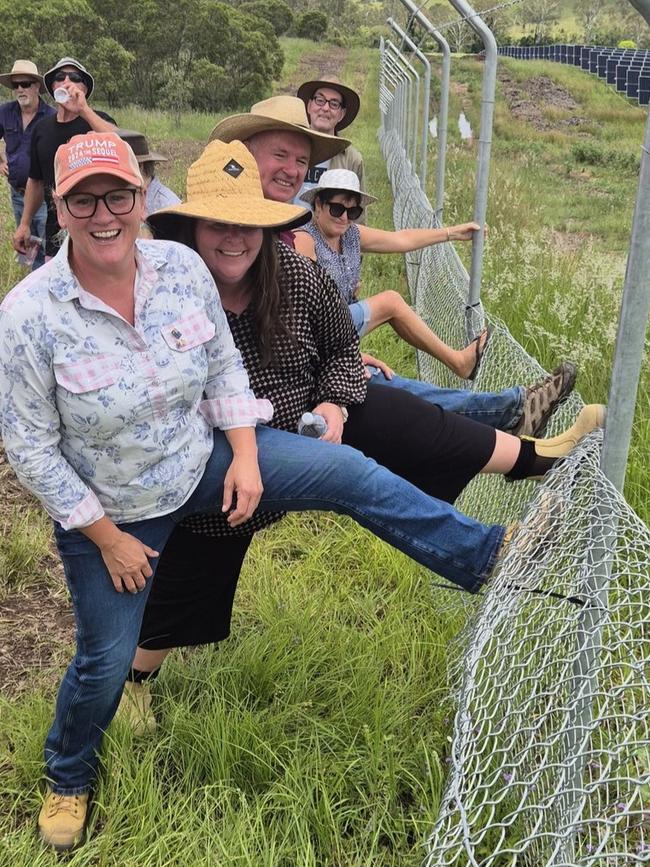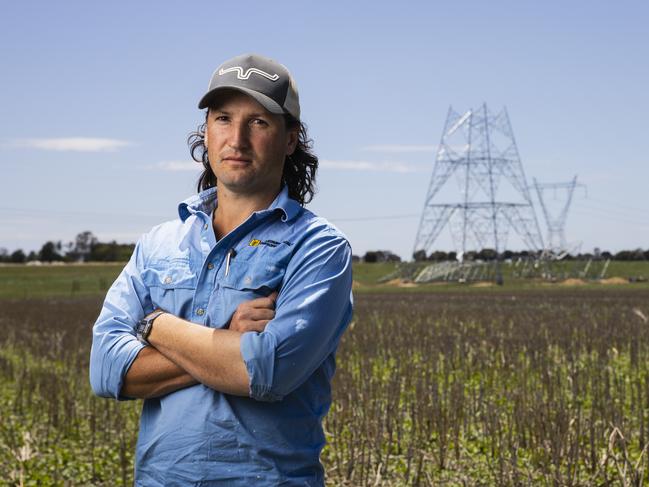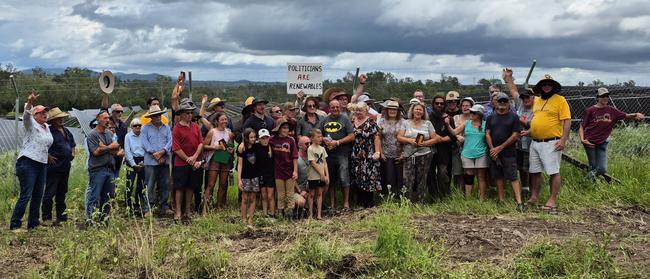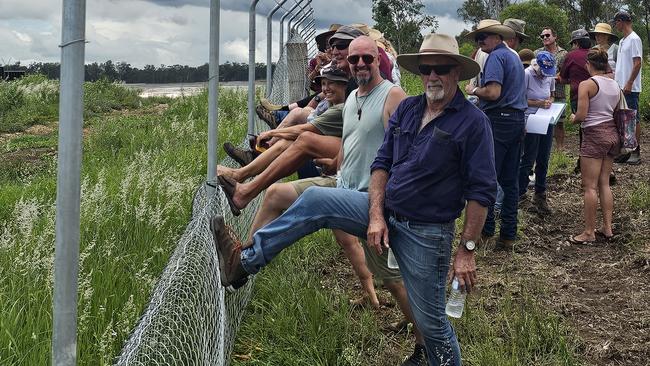Queensland locals stand up to solar farm, remove security fence
At first, Michelle Hunt thought her complaint seemed clear-cut, after a neighbouring solar farm had burnt down the boundary fence and erected their own monstrosity. After frustrating delays, locals took matters into their own hands.
At first, Queensland landholder Michelle Hunt thought her local council would deal with the neighbouring solar farm because her complaint seemed clear-cut. They had driven a bulldozer through her block, ripped out and burnt the existing boundary fence, and erected their own 1.8m chain wire monstrosity without her permission.
Then she went to police alleging trespass and wilful damage: you can’t just drive on to someone’s property and construct a 350m-long security fence that would look more at home around a prison than on rural acreage, can you?
She tried her local member of parliament and her federal member, met with state bureaucrats and eventually secured a meeting with the foreign-owned solar farm developers who, she says, admitted the mistake.
OK, she thought, just put the farm fence back and build your own security fence on your own land beyond the promised 10m vegetation corridor as per the development approval.
Months later, with little progress, Hunt took matters into her own hands.
Earlier this month, about 70 people from throughout southeast Queensland gathered on her 10ha block near Gin Gin, 30 minutes west of Bundaberg, and tore down half of the new security fence.
“I was a little bit shocked at the support that came, after dealing with this pretty much on my own for seven months,’’ she says. “We didn’t want vigilantism, we wanted it to be positive and peaceful, and it was; everyone stayed on my side of the property and we only folded down half of the fence.’’

It was a protest, a fightback reflecting the frustration of landholders who fear the steady erosion of their rights in the face of developers riding roughshod over communities being asked to do the heavy lifting in Australia’s clean-energy transition.
In rural pockets around the country, farmers and landowners are tied up dealing with lawyers, contracts, agreements, compensation, valuations and insurance uncertainty as wind, solar, battery and transmission infrastructure are rolled out with increasing urgency as part of the transition away from coal.
For some, it’s an economic windfall – a passive income stream that will contribute to the country’s clean-energy future. But others feel they have been thrust into the wild west where normal rules don’t apply and where little has been done to rein in cowboy operators, despite government promises to do so.

Last month The Australian revealed the plight of NSW Riverina farmer James Petersen’s ongoing battle with contractors building high-voltage transmission lines through his property. Unwanted fencing, dead sheep and biosecurity lapses are just part of his battle. Other farmers told of being locked off their properties, having gates left open and stock escape, and property management plans and biosecurity agreements flouted.
Strong supporters of renewable energy also sounded warnings with Victorian federal independent Helen Haines last year, saying that many regional communities feel as though their needs and aspirations are being ignored by international companies seeking to profit from Australian resources.
While some dismiss the complaints as nimbyism, the new energy and infrastructure commissioner, Tony Mahar, said the concerns of rural and regional Australians are real and that energy developers had to work on their consultation if they wished to gain social licence for their projects.

Up near Bundaberg, Hunt said she’d made peace with the idea of the $150m solar farm on a former cattle grazing property neighbouring the vacant block where her family had planned to build their dream home.
She was reassured by the conditions of the development approval that stated the security fencing would be set back inside the solar property beyond a 10m-wide vegetation buffer to screen out the panels.
Hunt and her family currently live three hours away from their acreage due to her husband’s work, so she was surprised last June to learn from a neighbour that a new boundary fence was being constructed.

They arrived back to find their front fence had been dropped and dozer tracks running through their property to the back boundary where a 4-6m section of her land had been flattened and the existing four-string barbed-wire fence removed.
In its place is a chain-wire fence with a rolled barbed-wire top that her children likened to a prison fence. Security cameras are due to be installed on it and Hunt doesn’t much like the idea of that either.
Since then, she likens her case to a political football. Bundaberg Regional Council said it would investigate, and seven months on that investigation continues. The police said it was a Fencing Act matter and directed her to the Administrative Appeals Tribunal.
“I don’t really understand that because if I drove a bulldozer on to a neighbour’s property without permission and took down a fence I’m pretty sure I’d be leaving in a police wagon,’’ she says.
State government officials couldn’t offer much help and directed her back to council.
In the meantime, she discovered that a timber corner post denoting the side boundaries has been moved and now she needs to get surveyors in to check her boundaries.
“So I’m expected to pick up the cost of that, and of going to QCAT, to fix something that I wasn’t responsible for.’’
Hunt says the solar farm operators had said they had tried to contact her but she is adamant she never heard from them. When she finally had a formal meeting with them after the fence was built it was agreed the situation would be rectified.
A letter dated October 14, seen by The Australian, said: “The security fence will be relocated to be set back inside the project and the farm fence reinstated as per the original specification. The landscape planting will be between the farm fence and the security fence as originally planned … We will send you updated details of the fencing arrangement shortly.’’
In that same meeting she was assured security cameras would be directional and unable to video her property.
Since that October meeting Hunt says she’s heard nothing more.
The Australian contacted the solar farm developer, Global Power Generation Australia, jointly owned by Spain’s Naturgy and the Kuwait Investment Authority. It did not respond to questions.
Hunt says the only help she’s received is from Senate Libertarian candidate and property rights activist Jim Willmott, who helped organise the protest to dismantle half the fence. “Michelle has been treated very badly,’’ Wilmott says. “They probably think they can just ignore it long enough and Michelle will go away but she’s not the kind of woman to go away.’’
He says people were motivated to attend the fence protest out of frustration and concern about what is happening in rural communities being targeted for renewables projects and the perceived lack of protection for the rights of landholders.
When this process began Hunt says she wasn’t aware of the renewables debate and wasn’t interested in politics. Now, “as she learns more”, she’s all for the Libertarians and property rights movement.
“People have said to me, ‘you’ve got a new fence, what are you complaining about’, or they say I could just sell my property and walk away, but why allow them to do this? For me, it’s the principle of the thing.’’







To join the conversation, please log in. Don't have an account? Register
Join the conversation, you are commenting as Logout